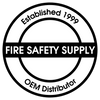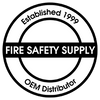Fire Safety Glossary: Common Terms Explained
Fire safety is a complex field with its own set of specialized terms and jargon. Whether you're a business owner, safety officer, or simply a concerned individual, understanding these terms is crucial for making informed decisions about fire protection and safety. This glossary is designed to clarify common fire safety terms, helping you navigate the world of fire prevention and suppression more effectively.
A
AFFF (Aqueous Film-Forming Foam)
A type of fire suppressant used to extinguish flammable liquid fires by creating a film that cools the fire and prevents oxygen from reaching the flames.
ABC Extinguisher
A multi-purpose fire extinguisher suitable for Class A (ordinary combustibles), Class B (flammable liquids), and Class C (electrical) fires.
Alarm Initiating Device
A component of a fire alarm system that detects signs of fire, such as smoke or heat, and activates the alarm.
B
Backflow Preventer
A device installed in a piping system to prevent the reverse flow of water, which could contaminate the water supply.
Ball Valve
A valve that controls the flow of water or fire suppression agents through a system, commonly used in sprinkler systems.
Booster Pump
A pump used to increase the pressure of water in a fire suppression system, ensuring adequate flow to sprinklers or hoses.
C
Carbon Dioxide (CO2) Extinguisher
A type of fire extinguisher that uses carbon dioxide to displace oxygen and suffocate the fire, effective for Class B and C fires.
Class A Fire
Fires involving ordinary combustibles such as wood, paper, and cloth. These fires are typically extinguished with water or ABC extinguishers.
Class B Fire
Fires involving flammable liquids like gasoline, oil, and grease. These require extinguishers designed for flammable liquids, such as foam or dry chemical extinguishers.
Class C Fire
Fires involving energized electrical equipment. Non-conductive extinguishing agents like CO2 or dry chemical extinguishers are recommended.
D
Dry Chemical Extinguisher
A fire extinguisher that uses a powder composed of sodium bicarbonate, potassium bicarbonate, or monoammonium phosphate to extinguish fires, particularly effective on Class B and C fires.
Deluge System
A type of fire suppression system that releases a large volume of water through all sprinklers simultaneously in response to a fire, typically used in high-hazard areas.
Dampers
Devices installed in ductwork that close automatically in response to heat, preventing the spread of fire and smoke through the ventilation system.
E
Emergency Lighting
Battery-powered lighting that automatically activates during a power outage to provide visibility and guide occupants to safety during an emergency.
Escape Route
A planned and marked path that leads to a safe location outside the building during an emergency. These routes must be kept clear and unobstructed.
Extinguishing Agent
A substance, such as water, foam, CO2, or dry chemical powder, used to put out a fire by cooling the burning material, cutting off oxygen, or interrupting the chemical reaction.
F
Fire Alarm Control Panel (FACP)
The central hub of a fire alarm system that monitors inputs from detection devices and controls outputs such as alarms and suppression systems.
Fire Door
A door with a fire-resistance rating used to prevent the spread of fire and smoke between compartments within a building.
Fire Load
The total amount of combustible material in a specific area, used to assess the potential severity of a fire and determine necessary fire protection measures.
G
Gaseous Fire Suppression System
A fire suppression system that uses gas, such as FM-200 or Inergen, to extinguish fires by reducing the oxygen level or interrupting the chemical reaction.
Gas Detector
A device that detects the presence of specific gases and triggers an alarm if dangerous levels are detected, often used in conjunction with fire suppression systems.
Gravity Tank
A water tank positioned above the fire protection system that uses gravity to supply water to sprinklers and hoses in the event of a fire.
H
Halon
An extinguishing agent used in fire suppression systems, which has been largely replaced due to environmental concerns. It works by interrupting the chemical reaction of the fire.
Heat Detector
A fire detection device that senses changes in temperature or heat levels and activates the fire alarm when a certain threshold is reached.
Hydrant
A valve located on the outside of a building that provides access to the water supply for firefighting purposes.
I
Inergen
A clean agent used in fire suppression systems that displaces oxygen and cools the fire, effective in areas where sensitive equipment is present.
Inspection
The regular examination of fire protection systems and equipment to ensure they are operational and compliant with safety regulations.
Isolation Valve
A valve used to isolate a section of a fire protection system for maintenance or repair, ensuring that the rest of the system remains operational.
J
Junction Box
A protective enclosure for electrical connections, often used in fire alarm systems to ensure connections are safe and secure.
Jacketed Hose
A fire hose with a protective outer layer or jacket that provides additional durability and resistance to abrasion and damage.
Jockey Pump
A small pump used to maintain pressure in a fire protection system, ensuring that the system is always ready to respond to a fire.
K
K-Class Fire Extinguisher
A fire extinguisher specifically designed for use on fires involving cooking oils and fats, commonly found in commercial kitchens.
Kinetics
The study of the rates at which chemical reactions occur, important for understanding how different fire suppression agents work.
L
Ladder Truck
A type of fire engine equipped with a ladder that can extend to reach high places, allowing firefighters to access elevated areas and perform rescues.
LPG (Liquefied Petroleum Gas)
A flammable hydrocarbon gas used as fuel for heating and cooking, which requires specific fire safety measures to handle and store safely.
M
Manual Pull Station
A device that allows individuals to manually trigger the fire alarm system in the event of a fire, often located near exits and high-traffic areas.
Misting System
A type of fire suppression system that uses a fine mist of water to cool and extinguish fires, effective in reducing damage and suppressing smoke.
Monitoring System
A system used to continuously check the status of fire protection equipment and systems, providing alerts for maintenance or malfunctions.
N
NFPA (National Fire Protection Association)
An organization that provides codes and standards for fire protection, aimed at reducing the risk of fire and ensuring the safety of life and property.
Nozzle
A device attached to the end of a fire hose that controls the direction and flow of water or fire suppression agents.
Nurse Call System
A system used in healthcare facilities to alert staff to emergencies, including fire alarms and patient requests, ensuring prompt response and safety.
O
OSHA (Occupational Safety and Health Administration)
A federal agency responsible for enforcing safety and health regulations in the workplace, including fire safety standards and practices.
Overhaul
The process of inspecting and cleaning an area after a fire has been extinguished, to ensure that all hotspots are identified and properly extinguished.
P
PPE (Personal Protective Equipment)
Gear worn by firefighters and other emergency personnel to protect themselves from hazards, including helmets, gloves, masks, and protective clothing.
Pre-Action System
A type of fire suppression system that requires two triggers to activate—typically a fire detection signal and a manual or automatic release mechanism—to prevent accidental discharge.
Pressure Relief Valve
A device used to release excess pressure from a fire suppression system, ensuring that the system remains within safe operating limits.
Q
Quick Response (QR) Sprinklers
Sprinklers designed to activate more quickly than standard sprinklers, providing faster response to small fires and reducing water damage.
Quenching
The process of cooling and extinguishing a fire by applying a fire suppression agent, such as water or foam.
R
Radiant Heat
Heat energy transferred through infrared radiation, which can contribute to the spread of a fire and affect the design of fire protection systems.
Re-Entry Control
Measures to prevent individuals from re-entering a building or area that has been evacuated due to a fire, ensuring safety and security during emergencies.
Response Time
The time taken for emergency services to arrive at the scene of a fire after an alarm has been triggered.
S
Smoke Detector
A device that detects the presence of smoke, usually as an indicator of fire, and triggers an alarm to alert occupants.
Sprinkler System
A network of pipes and sprinklers designed to automatically deliver water to a fire, helping to control or extinguish it.
Standpipe System
A system of vertical pipes in a building that provides water for firefighting purposes, with hoses connected at various floors.
Sump Pump
A pump installed in the lowest part of a building to remove accumulated water, which could be important for maintaining fire protection systems.
T
Thermal Detector
A device that detects changes in temperature to identify the presence of a fire, often used in conjunction with smoke detectors.
Two-Stage Alarm System
An alarm system that has two levels of alerts, usually a preliminary warning followed by a more urgent alarm, to manage emergency responses effectively.
Transfer Switch
A device used to switch the power supply from the main power source to a backup generator during a fire or power outage, ensuring continued operation of essential systems.
U
Uninterruptible Power Supply (UPS)
A backup power source that provides emergency power to critical systems and equipment during a power outage, helping maintain fire safety systems.
Underwriters Laboratories (UL)
An independent safety certification organization that tests and certifies fire protection products to ensure they meet safety standards.
V
Ventilation
The process of removing smoke and heat from a building to improve visibility and safety for occupants and firefighters during a fire.
Vertical Shaft
A vertical conduit or pipe in a building used for the passage of fire suppression systems, such as sprinklers or standpipes, to multiple floors.
W
Water Mist System
A fire suppression system that uses fine water mist to extinguish fires by cooling, suppressing, and displacing the oxygen around the flames.
Wheeled Fire Extinguisher
A portable fire extinguisher mounted on wheels for ease of transport, typically used for large fires or in industrial settings.
X
X-Axis
Refers to the horizontal axis in graphical representations of fire detection and suppression system coverage, used to plan and evaluate system effectiveness.
Xenon Strobe Light
A high-intensity flashing light used as a visual alarm in fire protection systems to alert individuals in noisy or high-traffic environments.
Y
Yoke Valve
A type of valve used in fire protection systems, often found in sprinkler systems, that allows for the isolation of sections of piping for maintenance.
Yield Point
The point at which a material, such as a fire hose or pipe, will deform or fail under pressure, important for ensuring the safety and reliability of fire protection equipment.
Z
Zoning
The process of dividing a building or area into different zones for fire protection purposes, allowing for targeted response and control of fire suppression systems.
Zero-Discharge System
A fire suppression system designed to contain and manage all discharged agents, preventing any release into the environment and ensuring compliance with environmental regulations.
Understanding these fire safety terms is essential for anyone responsible for fire protection in residential, commercial, or industrial settings. By familiarizing yourself with these terms, you can better communicate with fire safety professionals, make informed decisions, and enhance the overall safety of your property. If you have any questions or need further clarification on these terms, don't hesitate to contact us.
 Since 1999, Fire Safety Supply has been the go-to for fire suppression products, industrial dry chemical systems, high and low-pressure CO2, vehicles, and clean agents. We serve various types of industries such as restaurants, commercial kitchen, wineries, and more.
Since 1999, Fire Safety Supply has been the go-to for fire suppression products, industrial dry chemical systems, high and low-pressure CO2, vehicles, and clean agents. We serve various types of industries such as restaurants, commercial kitchen, wineries, and more.